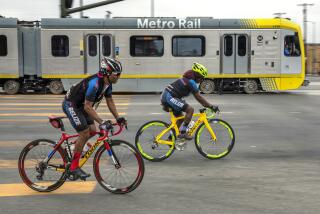Opinion: As L.A. reels from Porter Ranch gas leak, San Diego and Las Vegas vow to go carbon-free
- Share via
Welcome to the new world of urban climate politics post-Paris 2015. No sooner was the ink dry on the Paris accord than San Diego’s Republican mayor proudly announced that his city would become the largest city in the country to run entirely on renewable energy by 2035. Las Vegas had already beat San Diego to the punch, announcing well before the United Nations climate summit that it would go all green by 2025.
Instantly, all eyes turned to Los Angeles. As its neighbors vowed to go green, what was the second largest city in the country doing to follow suit?
The immediate answer wasn’t pretty.
L.A.’s effort to reduce greenhouse gas emissions is on the ropes right now because of the massive methane leak from a gas well at Porter Ranch — the equivalent of 7 million additional cars on the road every day, according to the Environmental Defense Fund. The leak is so large it will measurably set back not just the city’s but the entire state’s greenhouse gas emission targets, effectively erasing nearly a decade’s worth of statewide emission reductions.
Even before the leak began making international news, however, San Diego’s announcement put L.A. on the spot. Would the city step up to follow the trail its neighbors were blazing?
L.A. sustainability czar Matt Petersen lauded San Diego’s move in mid-December and said the cities share a common goal, but will get there by different paths.
Clearly, the first step on that path has to be plugging the Porter Ranch leak. Then comes the more difficult task of figuring out how to wean our city from fossil fuels entirely. The Los Angeles Department of Water and Power is moving to end coal power purchases by 2025 — a good start, but one that certainly looks paltry next to San Diego and Las Vegas’ grand announcements.
That said, once the Porter Ranch leak is resolved, L.A.’s green energy performance compared with its neighbors isn’t as dire as it may sound. When you hear that Las Vegas is going all green, give it up for Sin City — but hold on to your wits. Only the city’s municipal system — responsible for city lights, government buildings, fire stations, community centers and the like — is making a commitment to buy power from a big new solar plant in the surrounding desert. Sadly, there are no plans to power the Strip’s neon glitz with renewables any time soon.
And when you hear that San Diego has a step on Los Angeles, read the fine print. Both cities have the same commitment to reducing their overall carbon emissions — from all sources, including transportation — by 80% by 2050. They just have different strategies. San Diego decided to go all in with mandatory measures locked into law. That’s the news.
L.A., meanwhile, is using a voluntary approach that is more in line with the spirit of the Paris agreement — in which countries voluntarily set their own targets and pledged to report on their progress and adjust their goals going forward. L.A. may be forced to follow San Diego’s suit if environmental groups go to court to force cities to adopt mandatory measures. But, for now, the city is pursuing a mix of carrot and stick to get to the same aspirational goal.
Both approaches could work. It will be interesting to see which is more effective.
In Paris, voluntary carbon reductions were the only way to get many countries, including the United States, into the game. Those voluntary pledges don’t add up to enough reductions in greenhouse gas emissions to keep the planet from warming more than 2 degrees Celsius (3.6 degrees Fahrenheit) — a temperature beyond which, scientists say, will mean disastrous global consequences. California’s pledge to reduce emissions by 80% doesn’t get us there either. We’ll have to adjust our targets on the fly to get closer to the real goal: net zero emissions.
It is in this context that the developing competition for green supremacy between L.A., San Diego and Las Vegas could prove hugely important. Just as our states are laboratories for democracy, our cities are laboratories for climate change mitigation and adaptation. What works in one will be adopted by others, and that can add up to solutions for states, nations, and the planet.
Competition is a good thing. While things may look bad for L.A. as it faces the Porter Ranch crisis, hopefully the gauntlet thrown down by our neighbors will light a fire under the city to take decisive action. We’ve built up a solid cadre of professionals in city and state government, and the environmental groups that watchdog them. A decades-long competitive race between cities to reach carbon neutrality is certainly far better than the alternative, slouching toward climate apocalypse.
Jon Christensen is on the faculty of the Institute of the Environment and Sustainability at UCLA and is senior editor of Bending the Curve: Ten Scalable Solutions for Carbon Neutrality and Climate Stability.
Follow the Opinion section on Twitter @latimesopinion and Facebook.
More to Read
A cure for the common opinion
Get thought-provoking perspectives with our weekly newsletter.
You may occasionally receive promotional content from the Los Angeles Times.









